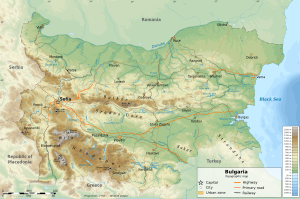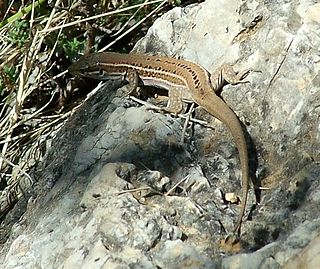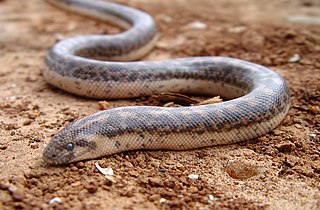
Bulgaria is a country in southeastern Europe situated entirely in the Balkan peninsula. The country is inhabited by 39 reptilian species, which makes reptiles the second least diverse class of vertebrates in the country, after Bulgaria's amphibians. [1] The list includes four species that have not been recorded in the country since the first half of the 20th century – the loggerhead sea turtle, green sea turtle, aspic viper and meadow viper. There are four turtle and two tortoise species of four families – Cheloniidae, Emydidae, Geoemydidae and Testudinidae; fifteen lizard species of four families – Anguidae, Gekkonidae, Lacertidae and Scincidae; and eighteen snake species of four families – Boidae, Colubridae, Typhlopidae and Viperidae. In addition, in recent years one turtle species, the North American pond slider, has been observed in numerous bodies of water all over the country; it has not reproduced successfully in the country and is not included in the list. [2] [3] The other two extant orders, Crocodilia and Rhynchocephalia, are not represented in Bulgaria.
Contents
- Status
- Order Testudines
- Family Cheloniidae
- Family Emydidae
- Family Geoemydidae
- Family Testudinidae
- Order Squamata
- Suborder Lacertilia
- Suborder Serpentes
- See also
- References
- Sources
- External links
The foundations of Bulgarian herpetology, or studies of amphibians and reptiles, were laid in the end of the 19th century by the teacher Vasil Kovachev, who published a number of articles on the subject and the 1912 book Herpetologic Fauna of Bulgaria. [4] In the 1930s and 1940s, the zoologist Ivan Buresh and his associate Yordan Tsonkov conducted in-depth research on the diversity and distribution of the amphibian and reptile species in the country. In the second half of the 20th century the leading Bulgarian herpetologist was Dr. Vladimir Beshkov. [4]
Bulgaria provides various habitats for reptiles. The country falls within six terrestrial ecoregions of the Palearctic realm: Balkan mixed forests, Rodope montane mixed forests, Euxine-Colchic deciduous forests, Aegean and Western Turkey sclerophyllous and mixed forests, East European forest steppe, and Pontic–Caspian steppe. [5] Bulgaria has varied topography. From north to south the main geomorphological regions are the Danubian Plain, the Balkan Mountains, the Sub-Balkan valleys, the Rila–Rhodope massif to the south-west, the Upper Thracian Plain and the Strandzha mountains to the south-east. Most of the country is situated within the humid continental climate region, with Alpine climate in the highest mountains and Mediterranean climate in the southernmost regions. [6] The highest diversity of reptiles is recorded in southernmost Bulgaria – the valley of the river Struma, the eastern Rhodope Mountains, the southern reaches of the river Maritsa and Strandzha.[ citation needed ] Reptiles are also most diverse at low altitudes; 15 species occur below 200 m (660 ft), and only five species are common above 1,200 m (3,900 ft). [7]
























































